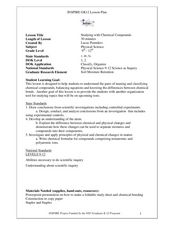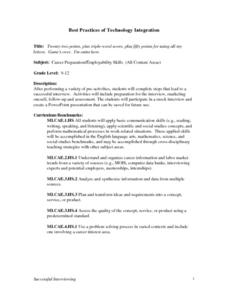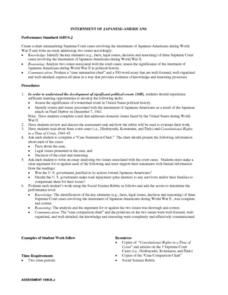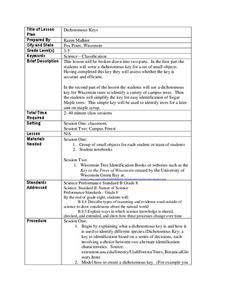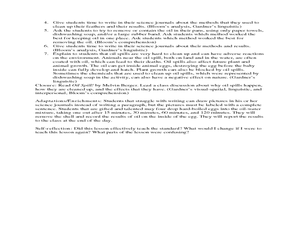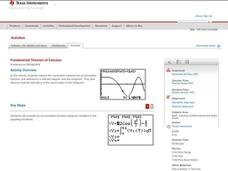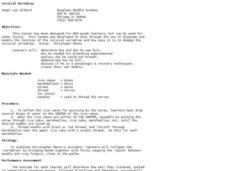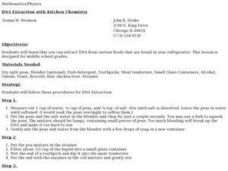Curated OER
Constellations
Third graders investigate space by researching their zodiac signs. In this space science lesson, 3rd graders discuss the different zodiac symbols, their star representation and where the stars are located in the sky. Students create a...
Curated OER
Studying with Chemical Compounds
Students create a foldable to help them remember topics on chemical compounds. In this physical science lesson plan, students differentiate ionic and covalent compounds. Given certain compounds, they identify whether it's ionic or covalent.
Curated OER
Successful Interviewing
After performing a variety of pre-activities, students will complete steps that lead to a successful interview. Activities will include preparation for the interview, marketing oneself, follow-up and assessment. The students will...
Curated OER
Internment of Japanese-Americans
Students assess the significance of a watershed event in the political history of the United States . They identify events and issues associated with the internment of Japanese-Americans as a result of the Japanese attack on Pearl Harbor...
Curated OER
Bioethics: Debates in Human Genetics
Students, in groups, research and prepare a debate regarding various bioethical situations. After the debates, each student prepares a ortfolio outlining their own personal opinions.
Curated OER
Attributes of Renewable Energy: From Nanopossibilities to Solar Power
High schoolers explore solar energy, why we use it and how we use it. In this renewable energy lesson students compare active and solar techniques.
Curated OER
Mining an Ore
Students investigate how to determine the percent composition of a mineral in an ore. In this mining an ore lesson plan, students use chocolate chips cookies to represent an ore and they remove precious minerals (the chocolate chips)...
Curated OER
Dichotomous Keys
Students utilize dichotomous keys to identify trees in their schools. In this ecological identification instructional activity, students practice creating dichotomous keys based on simple subjects such as hair color or sex of a person....
Curated OER
"I WONDER!"
Students explore a variety of age-appropriate resources. They answer a teacher-selected question about a science or social studies topic. They locate and review age-appropriate resources and provide practice in using the resources...
Curated OER
Local Weather And Location
Students explain how uneven heating of Earth affects wind and water currents. They describe the limits on current technology in predicting weather and how the Water Cycle is related to local weather.
Curated OER
Adopt a Tree
First graders describe the characteristics of a tree. In this science instructional activity, 1st graders create predictions about a book they will be listening to, Have you Seen Trees. Additionally, students describe their trees using...
Curated OER
Teaching Fundamental Movement
Students perform fundamental movement activities for flexibility and motor skills. For this movement lesson plan, students perform physical activity for all grade levels.
Curated OER
Cleaning an Oil Spill
Third graders use oil, feathers, eggs, rubber bands, and more to create a simulated oil spill and then clean it up. For this oil spill lesson plan, 3rd graders discuss what their cleaning process is like and how the oceans are effected...
Curated OER
What's the Frequency, Roy G. Biv?
Students examine the concept of frequency and wavelength. They analyze how frequency and wavelength relate to each other by conducting an experiment involving measuring and timing wavelengths by pulling adding machine tape through an...
Curated OER
Dinosaurs---Read All About Them!
Students read all about dinosaurs. In this biology lesson plan, students examine how to use library research as integral part of scientific research.
Curated OER
What's the Attraction
Students sort objects based on magnetism. In this magnetism lesson, students are given a variety of objects, then predict whether the object will be attracted to a magnet and test their hypothesis as they sort the objects into "yes" and...
Curated OER
Density And Volume
Sixth graders explore the concept of density as a relationship of an object's mass to its volume. Densities of a variety of objects are compared and used to identify an unknown object.
Curated OER
Propaganda & Persuasive Techniques: Do You Buy It?
Fifth graders investigate the basic persuasive techniques employed in advertising. They identify three examples of propaganda/persuasive techniques, complete an observation chart, take an advertising quiz, complete a spreadsheet that...
Curated OER
Fundamental Theorem of Calculus
High schoolers, with the assistance of their TI-84 Plus / TI-83 Plus calculators, explore and assess the connections between an accumulation function, one defined by a definite integral, and the integrand. They summarize that the...
Curated OER
Staying Young with Vitamin E
Investigate how Vitamin E is used to prevent cell aging. Young scientists coat the surface of apples and bananas with oil, Vitamin E, and water. They place each in a petri dish and cover them to observe oxidation over time. They answer 8...
Curated OER
Cervical Vertebrae
Eighth graders investigate the cervical vertebrae through models and diagrams. In this cervical vertebrae lesson plan, 8th graders use rice cakes, straws, marshmallows and thread to model the vertebrae. They simulate a cervical vertebrae...
Curated OER
DNA Extraction with Kitchen Chemistry
Students extract DNA from green peas. In this DNA extraction lesson plan, students use a blender to chop up peas, they mix them with a little soap, they tenderize them and they mix them with alcohol to see the DNA precipitate through the...
Curated OER
Water Conditions
Learners investigate the importance of water in an environment with living things. in this water conditions lesson plan, students soak radish sees in water, vinegar, soap and alcohol. Learners remove the seeds, store them for a few days...
Curated OER
Know Your Cousins - Monotremas, Marsupials, and Placentals
Young scholars discover various mammals. In this biology lesson plan, students recognize characteristics of mammals and categorize mammal groupings. Young scholars describe how mammals grow inside the mother's body and resemble their...



